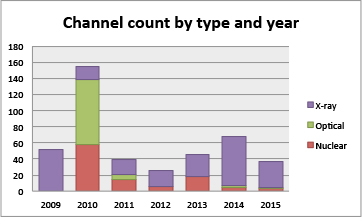Diagnostics
Plans for NIF diagnostics began with the Nova Technical Contract in the mid-1990s. At that time, the Joint Central Diagnostic Team was formed to coordinate efforts, working with their home laboratories, to develop NIF diagnostics funded through inertial confinement fusion (ICF) program funds at the various NNSA laboratories. The resulting strategy called for a national effort to develop and implement a comprehensive suite of diagnostics on NIF. Further, these diagnostics would be implemented in a phased manner and, when possible, multiple diagnostics would be available to measure key observables.

The need for multiple complementary and redundant diagnostics was recognized as an essential requirement since no single diagnostic makes a perfect measurement. For example, thermonuclear yield is measured by three absolute and independent diagnostics.
NIF makes nearly 120 diagnostics available to internal and external users. Optical diagnostics measure the light’s power, spectrum, and angular distribution of visible light to determine the energy balance of an experiment as well as the implosion velocity of the fuel capsule, laser–plasma interactions, and instabilities that affect the target performance.
Hard and soft x-ray emission detectors with micron-scale and picosecond-scale resolution characterize laser and target performance by measuring target self-emission or by using the x-rays to probe or radiograph dense matter. Nuclear diagnostics signal the presence of high-energy neutrons and measure physical properties such as neutron yield, ion temperature, bang time, core temperature, and reaction history.
NIF diagnostics are either constructed and deployed to a fixed location in the target chamber/target bay or are fielded on a diagnostic instrument manipulator (DIM). DIMs are two-stage telescoping devices capable of inserting, retracting, positioning, and aligning a diagnostic instrument in the Target Chamber, from the interior wall to Target Chamber center. DIMs can fit in a number of designated Target Chamber ports but are currently mounted in three locations: one in the target chamber pole and two on its equatorial plane. The DIMs also provide a standard set of utilities and cables to support operation of all DIM-based diagnostic instruments.
Table 7-3, also found in the NIF User Guide, identifies the NIF diagnostics and detectors currently available. The diagnostic location is given in terms of chamber coordinates. Diagnostics labeled “DIM” may be placed in the DIMs located at ports 90-78, 90-315, and 0-0. If an instrument is fixed but requires a pinhole or filter on a DIM, this is noted.
Diagnostics Implemented on NIF
Below are types of diagnostics, location, description of function and respective references:
For further information on scientific opportunities at the NIF, please contact:
User Office
PHONE: (925) 422-2179
nifuseroffice@llnl.gov



